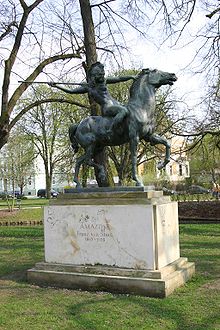

Karinhall ( German: Carinhall ) is a representative estate of the Reichsmarschall and one of the leaders of the Nazi Party, Hermann Goering , located in the Schorfheide forest between the Grossdölner and Wuckerssee lakes in the north of modern Brandenburg . The architect of this complex of buildings, erected in several stages, was first made by Werner Mark , the author of the Berlin Olympic Stadium . Later, his work was continued by Friedrich Hetzelt .
Goering named the estate in honor of his first Swedish wife, who died in 1931, Baroness Karin von Kantsov , nee Fock, whom he married in 1923 . After the destruction of her grave in Sweden, Goering transferred her remains to a crypt on the territory of Karinhall.
In the exhibition halls of Karinhall, Goering's private collection housed, consisting mainly of looted “captured” works of art. At Carinhall, Goering received the foreign government guests he hunted with in Schorfheide. On April 10, 1935, Goering's wedding with his second wife, Emmy Sonnemann, took place in Karinhall.
Until now, a granite pointer has been preserved near the place where the entrance to the estate used to be. The Carinhall building was blown up at the end of World War II in 1945 by order of Goering. Only some sections of the foundation masonry, cellars and fragments of columns have survived. The Amazon statue, which was previously west of the main entrance, was transported to Eberswald . There she was kept for a long time inside the church of Mary Magdalene, and then was transferred to the nearby Weidendamm park. Two gatehouses at the main gate are fully preserved and in good condition.
In 1943, Goering ordered that part of his collection be placed in shelter at the Altaussee salt mine in Styria . In 1945, these works of art were sent by the Allied authorities to Munich to the central collection point for displaced works of art, which was located in the Führerbau building and the NSDAP Administrative building .
Goering sent works of art that remained in Karinhall in January 1945 by special trains to Berchtesgaden , where they were stored in tunnels. Further, the objects of art were compiled in a bomb shelter . Some paintings and tapestries were stolen from cars in the last days of the war.
On April 20, 1945, Goering left Carinhall forever. The estate remained a small detachment of the Luftwaffe , which was tasked with blowing up the estate as the Red Army approached. When a few days later, Soviet troops were several kilometers from Karinhall, it was destroyed by 80 bombs dropped on it.
See also
- Wikimedia Commons has media related to Carinhall
- Bunker and art collection in Karinhall
Bibliography
- Andreas Kittler: Hermann Görings Carinhall - Der Waldhof in der Schorfheide 1. Auflage Druffel-Verlag, Berg 1997 ISBN 3-8061-1120-0
- Volker Knopf, Stefan Martens: Görings Reich. Selbstinszenierierungen in Carinhall . 3., überarbeitete und erweiterte Auflage. Links-Verlag, Berlin 2006, ISBN 3-86153-392-8
- Günther Haase: Die Kunstsammlung des Reichsmarschalls Hermann Göring. Eine Dokumentation. Edition q, Berlin 2000, ISBN 3-86124-520-5